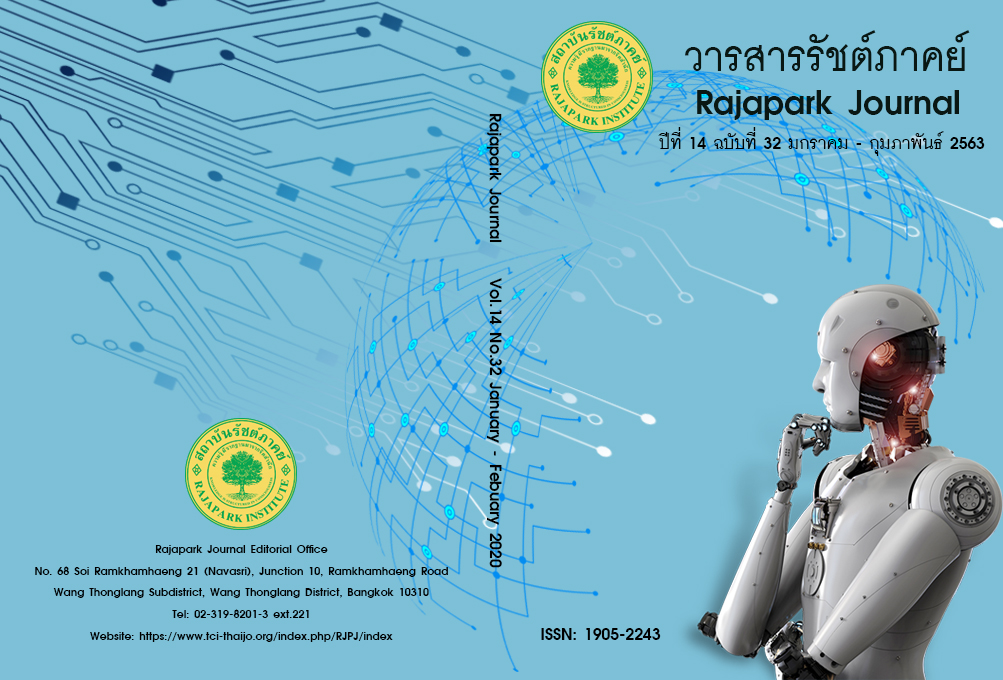A Study of Factors Relating to Perceived Teleworking Productivity of Telework Employees in Co-Working Space at Pathumwan Area and Watthana Area in Bangkok, Thailand
Main Article Content
Abstract
The purpose of this research is objectives of the research were to study the relationship between the satisfaction with long-distance employees' perceptions in the collaborative work areas in Pathumwan and Wattana districts in Bangkok. 1) cumulative demography 2) job satisfaction 3) satisfaction Damage in work 4) Attitude towards long distance work and 5) job satisfaction Collecting and discharging to enable the company to successfully gather SPSS research, analysis and analysis data. Surveying and sampling conducted using techniques that are not likely to be sampled used as telework staff and working at Co-working spaces in Pathumwan and Wattana districts totaling 400 people. Data were compiled by distribution.
According to the investigation of the relationship between attitude toward teleworking and perceived got a very weak positive relationship, it can be explained that, having a good attitude could create good productivity, as can easily say by those relevance factors will go in the same direction. It is mean a good attitude could create good productivity. The last relationship analysis is the relationship between organizational commitment and perceived teleworking productive. The outcome is very weak positive, which means if an employee who has a high organizational commitment or company loyalty, they will have high perceived teleworking productivity. From the result could be seen that, the effective employees would tend to have high bargaining power to negotiate with organization.
Article Details
Views and opinions appearing in the Journal it is the responsibility of the author of the article, and does not constitute the view and responsibility of the editorial team.
References
Agarwal, R. (2000). Individual acceptance of information technologies. in Zmud, R.W. (Ed.), Framing the
Domains of IT Management: Projecting the Future through the Past, Pinnaflex Education Resources,
Cincinnati, OH, 85-104.
Allen, T. D., Golden, T. D., & Shockley, K. M. (2015). How Effective Is Telecommuting? Assessing the Status of
Our Scientific Findings. Psychological Science in the Public Interest, 16(2), 40–68.
Allied Telecom. (2018). The History of Telecommuting. Retrieved from https://www.alliedtelecom.net/the-history-
of-telecommuting/
Avery, C., & Zabel, D. (2001). The flexible workplace: A sourcebook of information and research. Westport, CT:
Quorum Books.
Bailey, D. E., & Kurland, N. B. (2002). A review of telework research: Findings, new directions, and lessons for
the study of modern work. Journal of Organizational Behavior, 23, 383–400.
Belanger, F. (1999). Workers’ propensity to telecommute: an empirical study. Information & Management, 35,
-53.
Butler, E. S., Aasheim, C., Williams, S. (2007). Does telecommuting improve productivity?. Communications of
the ACM, 50(4), 101-103.
Carver, L. & Candela, L. (2008). Attaining organizational commitment across different generations of nurses.
Journal of Nursing Management, 16(8), 984-91.
Clean Air Council (2003). The green commute program. Retrieved from www.cleanair.org
Clear, F. & Dickson, K. (2005). Teleworking practice in small and medium-sized firms: management style and
worker autonomy. New Technology, Work and Employment, 20(3), 218-33.
Cooper, D. R., & Schindler, P.S. (2006). Business Research Methods, 9th Edition. McGraw-Hall International
Edition.
Greenfield, R. (2017). Telecommuting. Retrieved from https://www.bloomberg.com/quicktake/telecommuting
Hill, E.J., Miller, B.C., Weiner, S.P. and Colihan, J. (1998). Influences of the virtual office on aspects of work and
work-life balance. Personnel Psychology, 51(3), 667-83.
Igbaria, M., Guimarares, T. (1999). Exploring differences in employee turnover intentions and its determinants
among telecommuters and nontelecommuters. Journal of management Information Systems, 16(1),
-164.
Kizza, J. M. (2013). Ethical and social issues in the information age. London, England: Springer-Verlag.
Kurland, N. B., & Bailey, D.E. (1999). Telework: the advantages and the challenges of working here, there,
anywhere, and anytime. Organizational Dynamics, 28(2), 53-68
Lim, V.K., & Teo, T.S. (2000). To work or not to work at home: an empirical investigation of factors affecting
attitudes towards teleworking. Journal of Managerial Psychology, 15(6), 560-586.
Lupton, P. and Haynes, B. (2000). Teleworking – the perception-reality gap. Facilities, 18, 323-37.
Mann, S., Holdsworth, L. (2003). The psychological impact of teleworking: stress, emotions and health. New
technology, work and employment, 18(3), 196-211.
Meer, P. & Ringdal, K. (2009). Flexibility practices, wages and productivity: evidence from Norway. Personnel
Review, 38(5), 526-43.
Meyer, J. P., & Allen, N. J. (1997). Commitment in the Workplace: Theory, Research, and Application. Newbury
Park, CA.
Neufeld, D. & Fang, Y. (2005). Individual, social and situational determinants of telecommuter productivity.
Information & Management, 42, 1037-49.
Noonan, M. C., & Glass, J. L. (2012). The hard truth about telecommuting. Monthly Lab. Rev., 135, 38.
Retrieved from Scopus database.
Peters, P. & Heusinkveld, S. (2010). Institutional explanations for managers’ attitudes towards telehomeworking.
Human Relations, 63(1), 107-16.
Sparrow, S. M. (2000). New employee behaviours, work designs and form of work organization: what is in store
for the future of work?. Journal of managerial psychology, 15, 202-218.
US Department of Transportation. (2000). Workforce, 79(2), 28.
Westover, J., Westover, A. & Westover, L. (2010). Enhancing long-term worker productivity and performance:
the connection of key work domains to job satisfaction and organizational commitment. International
Journal of Productivity and Performance Management, 59(4), 372-87.
Wheatley, D. (2012). Work-life balance, travel-to-work, and the dual career household. Personnel Review,
(6), 813-831.
Zikmund, W.G. (2003). Business Research Methods. 7th Edition, New York: The Drylen Press.


